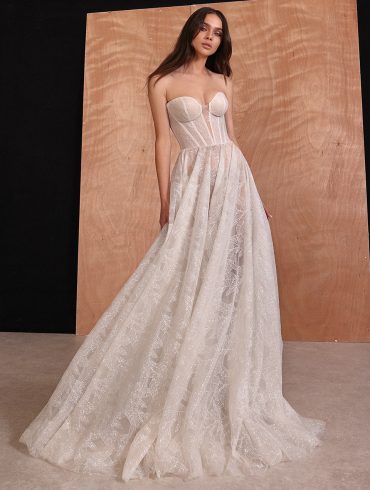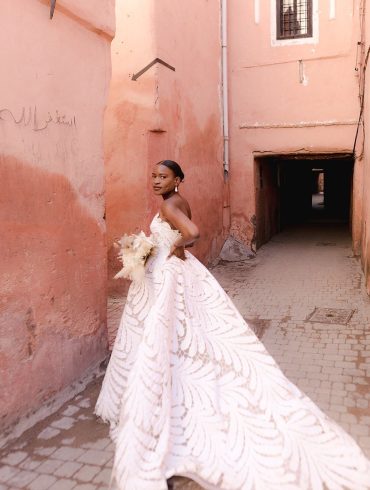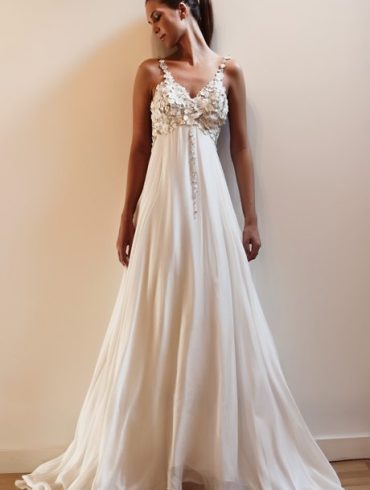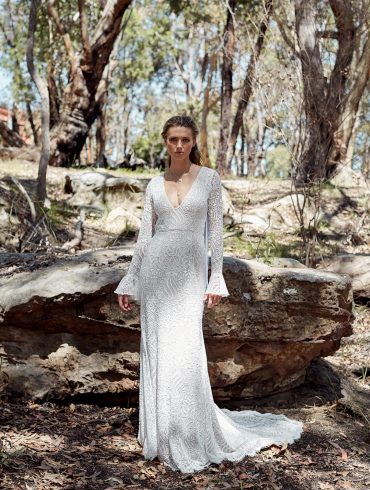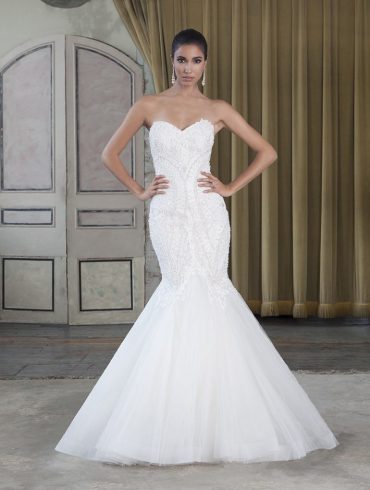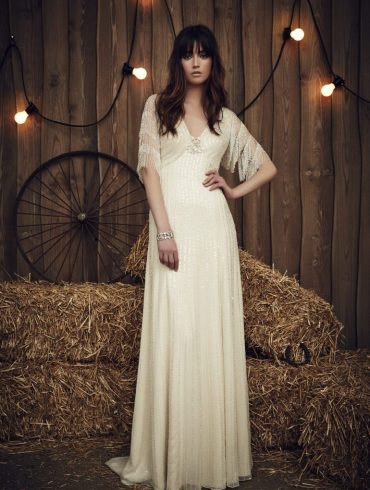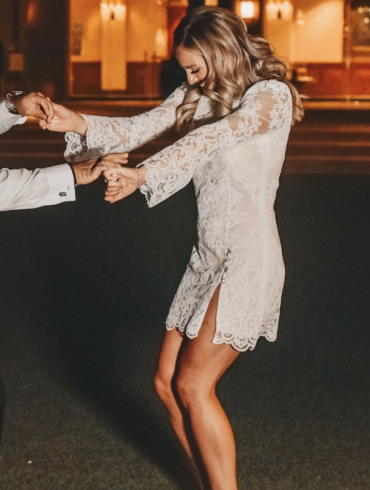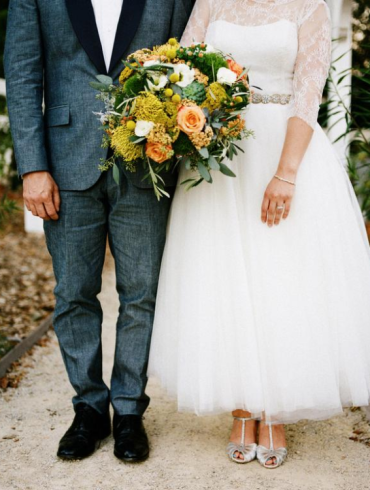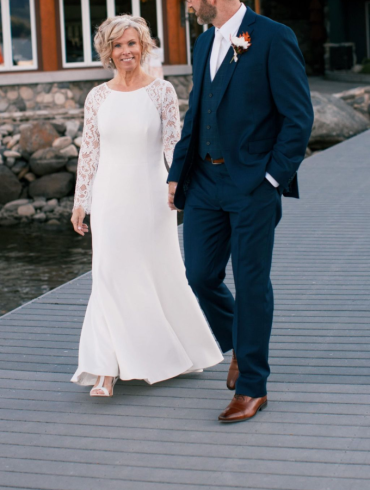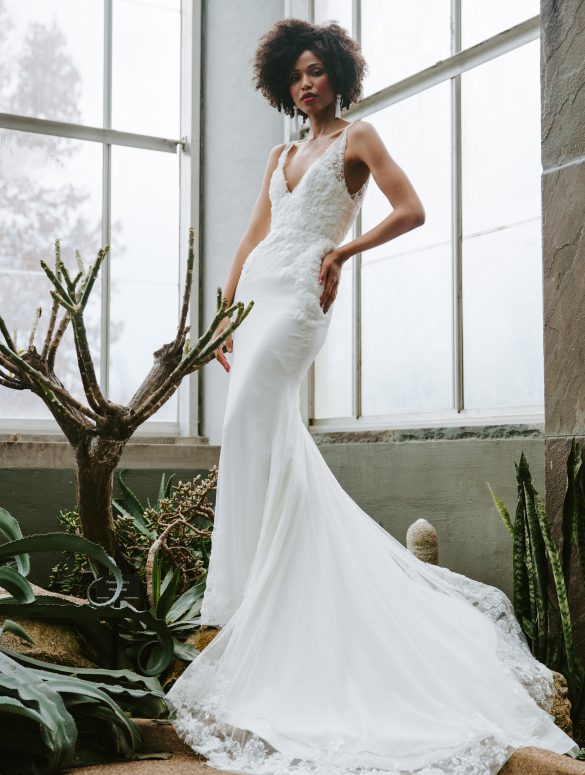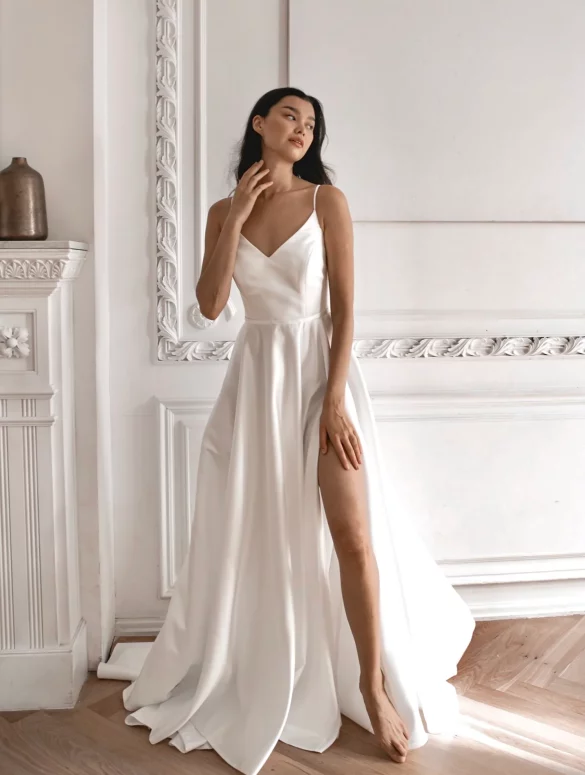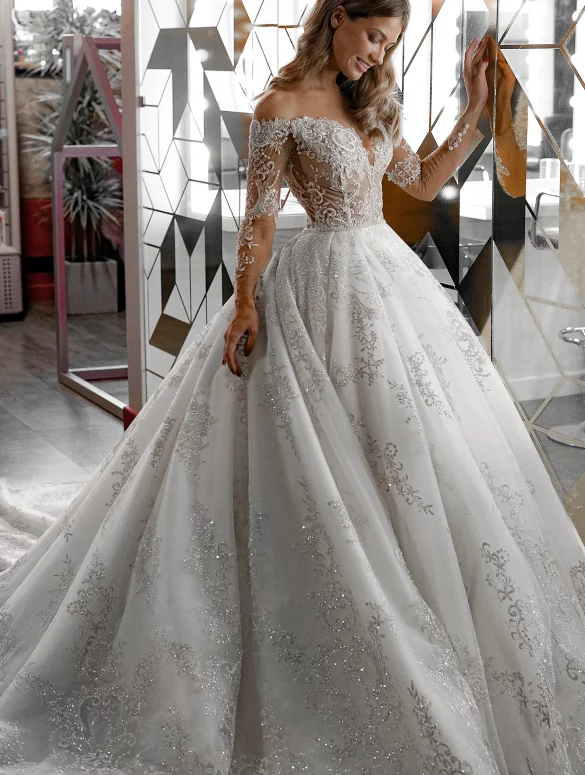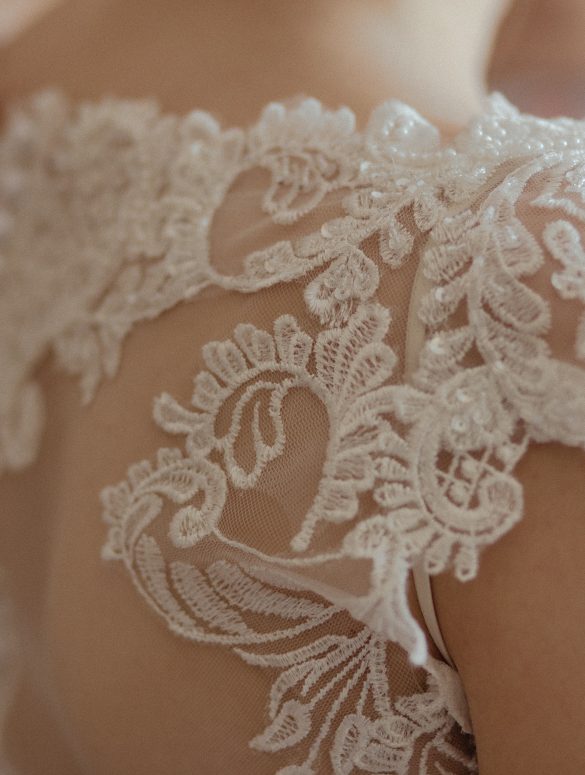The Ultimate Guide to Wedding Dresses
How to Choose Your Wedding Dress & Wedding Dress Inspiration
Silhouette / Length / Neckline / Waistlines / Fabric / Sleeves / Measurements / Colors / Personality / Your Shape / Tips
There’s no other tradition as synonymous with marriage as the white wedding gown. And for some brides, the process started years ago. Are you the bride who started looking for your wedding dress before you were even engaged? You’re not alone. While the daydreams are nice, the reality is that wedding gown shopping can be a little overwhelming. We pulled together our ultimate guide the wedding dresses as a way to help brides with their wedding planning process. When you think about what is involved in finding a wedding dress you can see how things quickly get stressful. You need to find out the basic cheat sheet for wedding gowns, understand the basic dress silhouettes and body types so you can understand how they flatter your figure and then you need to find a place to buy your wedding dress. If you’re feeling pressure to find the wedding dress of your dreams then read this ultimate guide to wedding dresses and take your time. Don’t worry and don’t rush.
Choosing A Wedding Dress Silhouette
A wedding is one of the most important days in anyone’s life. And in such a special occasion, one particular factor (also the most important factor to every bride) is the wedding dress. Every bride should be the center of attention on this big day with the wedding dress of their dreams. But it is really not an easy task to choose a perfect bridal gown. And the most important factor in my opinion is to choose the perfect wedding dress silhouette which can help flatter your figure. Here are some tips for different silhouettes to choose according to different body shapes. In a nutshell, to choose a perfect wedding dress is not only to care for its design itself but more important is to select the most suitable silhouette according to your figure. Always remember that you need a perfect wedding gown to flatter your body in your big day since it is all about you. What you need to know about each silhouette to help make a decision.
A-Line Wedding Dress Silhouette
An A-line silhouette is a timeless bridal shape that never goes out of style. Feminine and classic, the A-line wedding dress silhouette is fitted at the bust and natural waist before flowing out gradually to form an A shape. This style is known for being ideal for any type of figure as it draws the eye up toward the narrowest part of the body while creating a slimming waistline. It’s perfect if you’re envisioning an ethereal garden wedding and looking for a bridal gown that is flowy, lightweight, and romantic. A structured A-line bridal gown will give you a slightly fuller look that completes your chic and elegant vision. Depending on the design, an a-line gown can be anything from quite casual to extremely formal.
Looks Good On
Hourglass bodies
Round bodies
Pear-shaped bodies
Goes Well With
Beach / Garden weddings
Vintage / Boho weddings
Traditional weddings
Fantasy weddings
Romantic weddings
Modern weddings
Next Steps
Ballgown Wedding Dress Silhouette
Known for it’s full skirt and voluminous predisposition, the ball gown can make nearly any bride-to-be feel like a fancy Cinderella. The best part? It can minimize your waistline and disguise hips, buttocks and legs with it’s fitted bodice and full skirt. Not-to-mention it was made for twirling! Petite brides be warned: It can overwhelm a small frame. The gown features a waistline and a fitted bodice that leads down to a complete skirt. This ball gown silhouette is the probably the most formal and traditional shape of all and is for brides who want the Cinderella look. Like the A-line, this style is the a great for those who are not confident with their hips or legs. Shorter brides should avoid as fullness of the skirt can be overwhelming.
Looks Good On
Rectangular bodies
Hourglass bodies
Round bodies
Pear-shaped bodies
Inverted triangular bodies
Goes Well With
Traditional weddings
Fantasy weddings
Romantic weddings
Modern weddings
Next Steps
Empire Waist Wedding Dress Silhouette
An empire waist dress is a dress with a fitted bodice that drapes out under the bustline, rather than at the natural waistline. This shape’s effect is slimming and lengthening; the cinch at the bustline creates a high, thin waist and a longer line of billowy fabric from bust to hem than if you were to cinch the dress at your (lower) natural waist. Since empire waist dresses elongate the wearer’s frame, they’re especially great for petite women or plus-size women who want to redirect attention from their waist or hips to their bust. This is a type of dress became popular in the 19th century during the reign of Napoleon (and in ancient Greece). The empire style is highly versatile and has the ability to accommodate a wide variety of formality.
Looks Good On
Rectangular bodies
Hourglass bodies
Round bodies
Pear-shaped bodies
Inverted triangular bodies
Goes Well With
Traditional weddings
Fantasy weddings
Romantic weddings
Modern weddings
Next Steps
Flared cut / Fit-n-Flare Wedding Dress Silhouette
Fit and flare silhouette is perfect for the bride wanting a form fitted look without sacrificing comfort. Fitted from the bust through the hips with a subtle flare just above the knee, this shape elongates the body and accentuates the waist. A fit and flare style is an effortless way to show off an hourglass figure while still being able to move freely and dance on your wedding day. Curve defining, a fit and flare bridal gown compliments many different body shapes, and this timeless style be worn at any type of wedding venue during any season. Whether you want a chic and glamorous look or you want a sexy and dramatic mood, a fit and flare silhouette will make you feel incredible.
Looks Good On
Rectangular bodies
Hourglass bodies
Inverted triangular bodies
Goes Well With
Vintage weddings
Traditional weddings
Fantasy weddings
Romantic weddings
Modern weddings
Next Steps
Mermaid / Trumpet Wedding Dress Silhouette
If you have an hourglass or petite figure, the trumpet shape is probably your best bet at looking absolutely breathtaking on your special day. This understated silhouette effortlessly adds curves with just a touch of drama. Will hug your upper body and make your legs very grateful, as you will be dancing as freely and happily as you wish. A mermaid silhouette wedding dress is a style that highlights your curves in the most flattering ways. With a mermaid wedding gown, it is fitted through the top of the body and then flares out towards the bottom. A mermaid wedding dress is often paired with a stretch lining on the inside to provide more comfort on your big day!
Looks Good On
Hourglass bodies
Round bodies
Inverted triangular bodies
Goes Well With
Vintage weddings
Traditional weddings
Fantasy weddings
Romantic weddings
Modern weddings
Next Steps
Straight Cut / Sheath Wedding Dress Silhouette
Following the shape of the body from top to bottom, this gown style is typically cut on the bias so the fabric falls directly to the figure. Also known as a Column or Straight Cut or Sheath. It tends to hug the bust, waist, and hips, which helps add length to petite figures. This style comes from ancient Egypt’s commonly used Sheath gown. As the word’s meaning itself, this is a silhouette like a shield which wraps up the bride’s body tightly to show off women’s sexiness. However this style requires a particular figure. Those girls who have a larger figure should avoid the Sheath style. While for those lucky girls who are blessed with tall and slender figure, sheath is a great choice!
Looks Good On
Hourglass bodies
Pear-shaped bodies
Tall & Slender bodies
Goes Well With
Beach weddings
Garden weddings
Boho weddings
Traditional weddings
Modern weddings
Next Steps
Choosing Your Wedding Dress Length
Most of us think of floor-length gowns when we imagine a wedding dress. In reality, there are far more length options available to modern brides. Here’s everything you need to know when choosing the ideal length of your wedding gown. When you are thinking about your wedding dress length, you need to consider more than just what looks good. Here are something to consider when choosing your dress length:
Venue. Certain dress lengths lend themselves better to certain venues. For example, a knee-length gown might be an excellent option for a casual backyard or campground wedding. You should also consider that some religious settings like temples, churches, and other places of worship may have rules regarding what brides can and can’t wear. Be sure to do some research on your venue and it’s dress code before buying your dress.
Theme. Choosing a gown that matches your wedding’s theme will make the whole event seem more cohesive and polished. A floor-length gown adds some magic to a fantasy-themed wedding. On the other hand, a tea-length dress is an excellent choice for a 1950s theme or a garden party theme.
Season. It’s easy for brides to get wrapped up in style and fail to consider comfort. The last thing you want is to be sweltering hot or freezing cold during your big day. Remember to consider the weather you may experience during your wedding day, especially if you want to have photos taken outside. The shorter your hemline, the less likely your dress is to keep you warm.
Body Type. Nearly everyone looks good in a floor-length or knee-length dress. However, some lengths can look unflattering on certain body types. For instance, an ankle-length gown may help a shorter bride look taller, but a tea-length gown could make their legs look stubby. On the other hand, an ankle-length gown will most likely make a tall bride look somewhat awkward and gangly – as if her gown doesn’t quite fit.
When considering dress lengths, you may also want to think about trains. Do you want your gown to have a train? If so, how long do you want it to be? The terminology and measurements vary somewhat from designer to designer. But generally speaking, there are 4 different train lengths: Sweep trains (around 10 inches), Chapel trains (18-24 inches), Cathedral trains (up to 7 feet) and Monarch trains (up to 12 feet).
Short Wedding Dress Length
Above-the-knee dresses are arguably the least formal type of wedding gown, but they can still make a bold statement. These mini-dresses are excellent for brides who like a 1960s Mod aesthetic. Knee-length dresses are slightly more formal than above-the-knee dresses with a more feminine flair.
Medium Wedding Dress Length
Tea-length gowns usually hit mid-calf. This length was very popular in the 40s and 50s, making it a favorite among vintage-inspired brides. High-low dresses are typically shorter in the front and longer in the back, giving the bride the absolute best of both worlds.
Long Wedding Dress Length
Ankle-length gowns fall a few inches from the floor, making it easier to walk and dance without tripping or stumbling over the hem of your dress. Just like the name suggests, floor-length gowns go all the way to the floor. Ideally, the front of the hem will just barely brush against the ground without dragging.
Choosing A Wedding Dress Neckline
Every part of your wedding dress is important, but you could argue that the neckline is the most important part because it’s supposed to frame your beautiful smiling face. But there are so many neckline options, and it’s hard to know which styles suit which settings. We've broken down all the most popular wedding dress necklines into three categories to help you determine what type of neckline will suit your venue, theme, and overall style the best. The most important rule of choosing a neckline is that there are no rules. As long as you feel gorgeous and confident as you walk down the aisle, you've made the right decision.
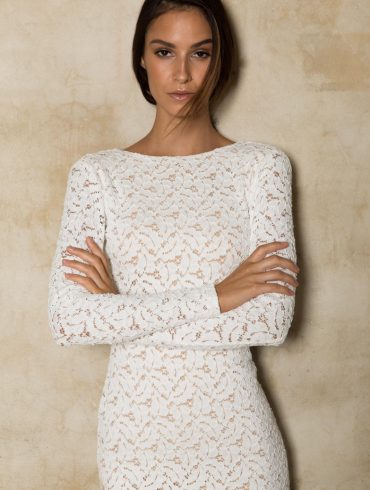
Conservative Wedding Dress Neckline Options
For many brides, their wedding is a sacred religious ceremony. Other brides choose to get married in venues with strict rules on how much skin the bride wants to show. A bateau neckline is wide with a very shallow curve, so it may almost look like a straight line from shoulder to shoulder. Bateau necklines are usually relatively high-cut. Straight necklines appear on strapless gowns and do not have any sort of dip or curve in the middle. This straight line can cover a little bit more cleavage than a sweetheart neckline or other strapless styles. A square neckline is very similar to a straight neckline. The only difference is that square necklines have straps or sleeves, which usually make a right angle to the horizontal part of the neckline. High neck gowns have become quite popular recently, particularly in choker-style and bib-style halter top gowns. These necklines typically sit at or even above the collarbone. A jewel neckline is slightly lower than a high neck and narrower than a bateau neck. This curved neckline usually sits just below the collarbone.
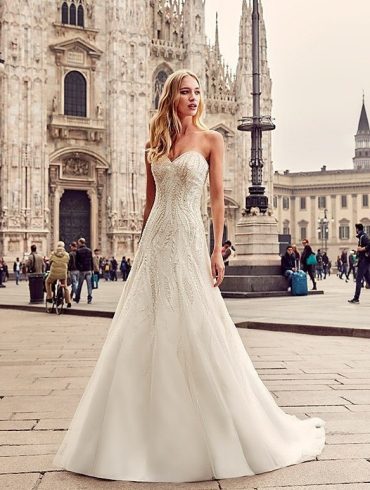
Classic Wedding Dress Neckline Options
Classic necklines work with virtually any setting and can show more or less skin, depending on the dress’s design. If you want something universally flattering, one of these necklines would be a great place to start. Sweetheart necklines curve up over the bust with a slight dip in the middle, resembling the top part of a heart. This is one of the most popular necklines because it looks good on everyone. Like the sweetheart neckline, a Queen Anne neckline curves over the bust with a dip in the middle. The major difference is that the neckline is more closed off, with straps or sleeves closing in towards the back of the neck. A V-neck starts wider at the top and comes down to more of a point towards the bust. This neckline is particularly flattering on brides with somewhat narrow shoulders. Portrait necklines are like a combination between a v neck and a bateau neck. Like a bateau neckline, portrait necklines are very wide. So wide, in fact, that they typically sit at the very edge of the shoulder. Portrait necklines usually come down to a point in the center.
Inspiration Galleries

Bold Wedding Dress Neckline Options
Some brides want their wedding gown to make a statement. These necklines tend to stand out and leave an impression as you walk down the aisle. When it comes to necklines, “plunging” typically just means very low cut. Very deep v-necklines would be one example of a plunging neckline. This option is both sultry and tasteful. A lace illusion neckline uses very fine, often flesh-colored mesh to make the dress look strapless or as if it's being held up buy very delicate appliques. Lace illusion necklines often look ethereal and romantic. Off-the-shoulder necklines have been a staple of evening wear since Queen Victoria's day, and even Beyond. When paired with trumpet gowns, off-the-shoulder necklines highlight the beautiful curves and structure of the bride's figure. Asymmetric necklines usually feature one strap or one sleeve with one bare shoulder. This playful look adds plenty of visual interest to your wedding day ensemble. The most important rule of choosing a neckline is that there are no rules. As long as you feel confident, you've made the right decision.
Inspiration Galleries
Wedding Waistlines 101
The waistline of a wedding gown is the seam where the skirt meets the bodice. Sometimes embroidery, beading, or other embellishments draw attention to this area, making it a focal point.
Whether you plan to wear bling at your waistline or keep it simple, it’s important to know what your options are and which one might look most flattering on you.
Empire Waist. An empire waist is the highest waistline available for wedding dresses. This waistline usually sits above the bride’s natural waist, sometimes directly under the bust. Empire-waist gowns give off a youthful and ethereal look, and they usually feature a line or sheath silhouettes. Empire waistlines are most flattering on brides with long torsos and shorter legs.
Natural Waist. A natural waistline is relatively self-explanatory – it sits at your natural waist, which is between the bottom of your rib cage and the top of your hips. This type of waistline looks gorgeous with any kind of silhouette. Natural waistlines are universally flattering, as they usually accentuate the smallest part of the bride’s torso.
Dropped Waist. A dropped waistline sits lower than your natural waist – usually around your hips, but sometimes even lower. Ball gowns with dropped waists can be breathtaking on brides who want to accentuate their hips. And, of course, all mermaid wedding gowns feature extremely dropped waists. Dropped waistlines are most flattering on taller brides with short torsos and long legs.
Basque Waist. Basque waistlines are something we might associate with medieval gowns or fantasy princesses. These waistlines come to a point in the center-front of the dress. Typical basque waistlines sit slightly lowers than the natural waist. Basque waists look regal-yet-playful with ballgown and a-line silhouettes. A basque waistline looks most flattering on a pear-shaped or hourglass bride.
Asymmetrical Waist. Asymmetrical waistlines typically cut a diagonal line from either the waist on one side to the hip on the other side, or the hip on one side and the mid-thigh on the other side. This type of waistline is very popular for a-line dresses as well as some ball gowns. Asymmetric waistlines are universally flattering and look good on virtually every body type.
No Waistline. Remember, when we’re talking about waistlines, we’re usually discussing the seam that attaches the skirt to the bodice. However, plenty of dresses don’t actually have this seam. Instead, they have long panels sewn together vertically, allowing the gown to conform to the bride’s natural curves. This technique is called princess seaming, and it is a gorgeous choice for any body type. You’re most likely to see princess seaming on a trumpet gown or the top portion of a mermaid gown.
Choose the Waistline That Builds You Up
Remember that these rules dictating what waistlines look best on what body types are subjective. Choose a waistline that makes you feel like the breathtaking bride you are. That’s the only thing that matters.
Wedding Dress Fabric 101
Fabric can really make or break a wedding dress. Each type of fabric has different qualities: the way it hangs, the way it catches the light, the way it moves, and so much more. Brides sometimes start shopping for their dress with a specific fabric in mind, not realizing that some fabrics are better suited to certain silhouettes than others.
Fabrics are either made from natural fibers or synthetic fibers.
Natural fibers. Natural fibers are made from naturally occurring materials, like cotton seed fibers or silkworm filaments. Generally speaking, natural fibers are breathable and better for the environment. They’re also typically less likely to trigger allergic reactions. The downside is that natural fibers are usually more expensive and less resilient, making them more vulnerable to stains. Common natural fibers used in wedding dresses include: Silk, Cotton, Vegan (hemp) silk, Linen (flax)
Synthetic fibers. Synthetic fibers are human-made, usually from petroleum. The fibers used to make synthetic fabrics are light-weight, resilient, and customizable – they can be manufactured to be thick, thin, dull, shiny, and virtually any texture a designer could want. Synthetic fibers are inexpensive to make; however, as a petroleum product, the manufacturing process does have an ecological impact. The fibers are essentially plastic, which means the fabrics don’t typically breathe as well as natural fibers.
Popular Types of Fabric
Crepe. Crepe is a drapey woven fabric with a slightly rippled texture. The texture gives the material a uniquely matte finish. Crepe is very light and flowy, making it an excellent choice for: Sheath gowns, Fit & flare gowns, A-line gowns. Crepe can be made of natural or synthetic fibers.
Satin. Satin fabric is usually characterized by its shine. Most satins have a shiny side and a dull side. Satin can have a high gloss or a very soft shine depending on the fiber and satin type. Evening wear is often made of satin because it drapes beautifully. Satin is an excellent choice for: Sheath gowns, Fit & flare gowns, A-line gowns. Satin can be made of natural or synthetic fibers.
Velvet. Velvet is soft and luxurious. Fibers stick straight up from the fabric in what’s called a pile, making it sort of fuzzy to the touch. Velvet is quite heavy, so it tends to hang relatively close to the body without supporting garments. It’s also quite warm, making it a toasty option for winter weddings. Velvet is an excellent choice for: Sheath gowns, Fit & flare gowns, A-line gowns, Ball gowns. Velvet can be made from synthetic and natural fibers.
Chiffon. Chiffon is a light and airy fabric that is usually sheer. This fabric is not heavy and is usually worn as a top layer of a garment. It is not particularly stiff, so chiffon is not the ideal choice for structural elements. Chiffon is an excellent choice for: Sheath gowns, A-Line gowns. Chiffon can be made of synthetic and natural fibers.
Taffeta. Taffeta is a crisp woven fabric that has a distinct sheen to it. The material itself is typically quite lightweight, but it tends to hold its shape quite well. Taffeta is known for the rustling sound it makes when rubbed together. Taffeta is an excellent choice for: Sheath gowns, Mermaid gowns, A-Line gowns, Ball gowns. Taffeta can be made of synthetic and natural fibers.
Jacquards. Jacquard fabrics are woven in a special way that makes them look like they’re printed or embroidered with elaborate shapes and patterns. Some jacquards are all one color while others incorporate different colors, sometimes including shades of gold and silver. Jacquards are an excellent choice for: Sheath gowns, Mermaid gowns, A-line Gowns, Fit & Flare Gowns, Ball Gowns. Jacquards can be made of synthetic and natural fibers.
Tulle. Tulle is a type of netting that’s often used in veils and wedding dresses. The netting varies in terms of stiffness. Some types of tulle are soft and flowy, while others are coarse and rigid. Tulle is traditionally used under ball gowns as a structural garment, adding volume to the skirt. However, recent wedding dress styles have used tulle as an outer layer. Tulle can be used in: Fit & Flare gowns, A-line gowns, Mermaid gowns, Ball gowns
Lace. Lace is a particular type of mesh that includes intricate patterns of swirls, flowers, and more. There are many different types of lace, all of which vary in texture, finish, weight, and stiffness. Lace can be used in: Sheath gowns, Fit & Flare gowns, A-line gowns, Mermaid gowns, Ball gowns.
Remember Your Venue
When looking at wedding dress fabrics, remember the setting of your big day. Some materials lend themselves better to certain environments. For instance, velvet or jaquards would likely be too heavy for a beach wedding. On the other hand, Chiffon and crepe are light and flowy enough to look right at home at the seaside. Considering your wedding dress fabric can help ensure you feel comfortable and beautiful on your wedding day.
Wedding Sleeves 101
When brides think of a wedding gown’s distinguishing features, they often don't even consider sleeves. However, sleeves can completely change the look of a dress, making it more formal, more casual, more classic, or more unique. This article will tell you everything you need to know about sleeves when you're on the search for your wedding gown.
What Are My Length Options?
When you hear sleeves, you may think exclusively of long sleeves a la Kate Middleton. However, wedding dress sleeves come in a variety of lengths. Here are the different sleeve lengths available for wedding gowns.
Sleeveless. The vast majority of wedding gowns are sleeveless. A sleeveless gown may have straps or be totally strapless. At most, a strapless gown will have fabric to the edge of the shoulder. Depending on the silhouette, sleeveless gowns can be both formal and casual. For instance, a sleeveless A-line gown is likely to be more casual, whereas a sleeveless ball gown would be considered more formal.
Capped Sleeves. Capped sleeves are very short, almost like very thick straps. The difference is that, unlike a sleeveless gown with straps, a capped sleeve gown has a few inches of fabric covering the curvature of the shoulder. Capped sleeves often create a sweet and innocent aesthetic, which goes well with ancient Greece or Regency-inspired sheath dresses.
Short Sleeves. Anything longer than a capped sleeve but shorter than the elbow would be considered a short sleeve. Depending on the fabric, short sleeves can be more formal or more casual. A fitted lace or crepe sleeve will create a more formal effect. Meanwhile, a chiffon flutter sleeve will likely feel more youthful and romantic.
¾ Length Sleeves. ¾ length sleeves typically fall between the wrist and the elbow. They are a popular choice with more mature brides; however, this style of sleeve is flattering for any age or body type. ¾ length sleeves look particularly stunning with wide necklines like off-the-shoulder, portrait, and bateau styles.
Long Sleeves. Long-sleeved wedding dresses have recently undergone a renaissance, arguably ever since Kate Middleton became the Duchess of Cambridge. But while her sleeves were fitted to the wrists, many popular modern long sleeve styles feature more volume and movement. Long fitted sleeves look quite formal and austere, while more billowy styles give off a vintage or bohemian look.
Popular Sleeve Styles
Flutter Sleeves. Flutter sleeves are drapey, flowy pieces of fabric that hang from the shoulders. They are called flutter sleeves because they are lightweight and almost give the appearance of small wings. Most flutter sleeves are short and made from a lightweight fabric like chiffon
Bell Sleeves. Bell sleeves are narrow at the shoulder and get progressively wider down towards the wrist. Depending on the fabric and style of the dress, bell sleeves can look medieval or bohemian.
Bishop Sleeves. Bishop sleeves were very popular in the 70s and have recently come back into vogue. They are usually relatively wide and billowy but are gathered into a simple fitted cuff at the wrist.
Poet Sleeves. Poet sleeves are similar to bishop sleeves in that they offer some excess volume through the arm and are gathered more tightly around the wrist. The major difference is that there is usually a small ruffle instead of a cuff at the wrist.
Fitted Sleeves. Fitted sleeves are arguably the most classic and timeless. This style of sleeve simply conforms to the shape of the arm, fitting closely from the shoulder to the wrist. Fitted sleeves are a popular option for more religious ceremonies as they offer complete coverage and balance modern style and traditionalism quite nicely.
Wedding Dress - Taking Dress Measurements
Within the world of weddings—specifically bridal fashion—it’s imperative that the right size is ordered and the correct alterations are made. And without the proper measurements, the necessary task of choosing a dress can quickly go awry. If you aren’t ordering through a bridal boutique with professionals to take your measurements, you’ll need to know the correct way to use your measuring tape. Sizing is already an entirely different experience when it comes to the style of the bride, so allow us to make it a pinch easier for you to manage. Take a peek at these quick tips and tricks for getting every inch just right! Before you start measuring this length and that width, make sure to read through all the essential steps below and learn the proper way to ensure the right sizing and fit.
Bust. Your bust measurement will be the circumferences of the fullest part of your chest. The measuring tape will circulate from the front to the back, and it will usually cross through the nipples. It’s vital that you measure the fullest part of your bust area for the best and closest fit.
Waist. When taking your waist measurement, you’ll be doing the opposite of the bust. Instead of the fullest part of your waist, you want to find the most narrow. The belly button is the usual spot for finding your true waist measurement. Again, this will be the circumference of the area, and the measuring tape should go from the front to the back to find the correct measurement.
Hips. Now we move onto the hips, and we’re looking for fullness again. You will want to take the circumference of the fullest part of your hip area—from the front, circulating all the way around the back with the measuring tape to ensure the most accurate measurement.
Back Width. You may need this measurement for custom gowns, for example. And it’s a simple one! This measurement is simply the horizontal distance of the widest section of the back.
Shoulder Width. This measurement is a “tip to tip.” And all that means is that you need to measure from the top tip of one shoulder all the way across to the other for the proper measurement. It’s important that you keep the tape held taut, as well.
Front/Back Length. Your front length will help with torso fittings. This is the vertical distance between the baseline of your neck to the top of your waistline.
Hollow-to-Hem. One of the most interesting of the bunch is this measurement as it’s not always taken for evening gowns but should be. This measurement will ensure that the distance between the base of the neck to the hem of the dress is just right. *It’s important to note that with heels on, a properly fitted gown’s hem will just graze the floor.
Tips for Measuring Wedding Gowns Correctly
Do not measure a dress you’re wearing yourself. Make sure you have someone with you to ensure you are getting the proper measurements.
Stand straight, shoulders back, and heels together. Slouching or having your feet apart will create inaccurate sizing.
Four measurements are always required: Bust, Waist, Hips, and Hollow-to-Hem.
Wear the shoes. Wear the shoes you want to wear on your big day.
Wear the undergarments too. The proper undergarments ensure a proper fit and better measurement too.
Think about getting a pro. Hire a professional tailor or alterations specialist.
Anticipate any growth you may have. Are you pregnant? Account for this fluctuation.
Parallel to the floor is key. Think about the measuring tape like a level—you don’t want it diagonal or the picture will fall.
Using Your Wedding Dress Designer’s Size Chart
As mentioned previously, every designer will have their own size chart. It’s imperative to get your correct measurements, and then compare them to the size chart of whatever brand you are purchasing from. Once you have your numbers, consult the chart and find the size that will work. Note that often you will see a label size and street size, and yes, there is a difference.
Here’s the process in 4 easy steps:
Step 1: Compare your bust, waist, and hip measurements to the size chart.
Step 2: Find your measurements on the chart. Say, for example, you see that your bust fits a 10, your waist fits an 8, and your hips fit a 12.
Step 3: Order up to a 12, and size the rest down to get a custom fit for your shape.
Step 4: Don’t be surprised by the size you end up ordering—more often than not, brides will be ordering 2–3 sizes above their normal, everyday clothes.
What the Color of Your Wedding Dress Says About You
We know that certain colors tend to create different meanings, and that’s no exception in the world of wedding gowns. Red evokes a sense of passion and pink exudes youthful femininity. When you’re trying to create a sense of warmth and welcomed appeal in your home, you may go the traditional route by dipping your living room in dark neutrals or if you’re creating a sense of calmness you may decide to dress a bedroom in blue. So, what happens when you want a bohemian wedding or a ceremony that hints at mysterious romance? Well, you start with the dress, of course. If you’re wondering what the color of your wedding dress says about you, look no further than our cheat sheet below. We’ve taken all of the most popular bridal tones and expanded on their meanings, their messages, and what kind of vibes they dwell best in.
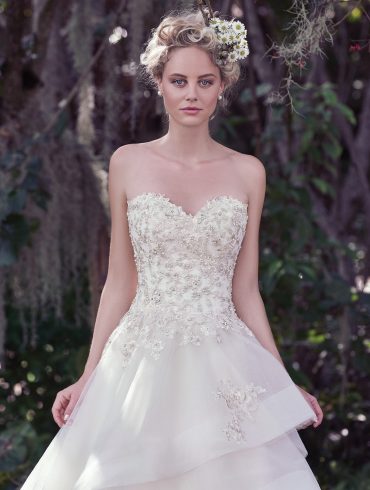
White Dress
While the elite Europeans and Americans took to the white wedding dress trend pretty quickly, the middle class brides were not able to adapt to this wedding style until after WWII. In 1981 the new trend of wearing white skyrocketed due to the televised wedding of Princess Diana and Prince Charles. 82% of brides still chose to wear the traditional “white wedding dress”.
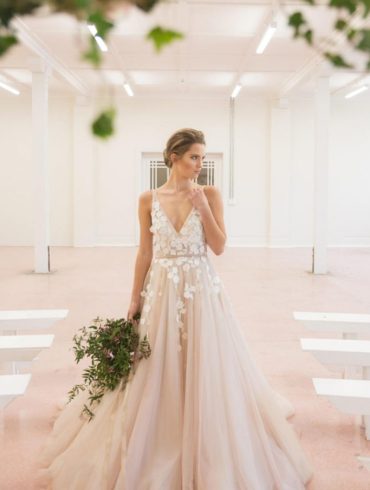
Blush Dress
This dazzling and delicate pink has been consistently popular in the wedding scene for years. There’s something really romantic and pure about a bride that’s been dipped in blushing pinks. And in present times, it’s nearly as traditional as going with a white or ivory gown. For those looking for a youthfully spirited and trendy event.
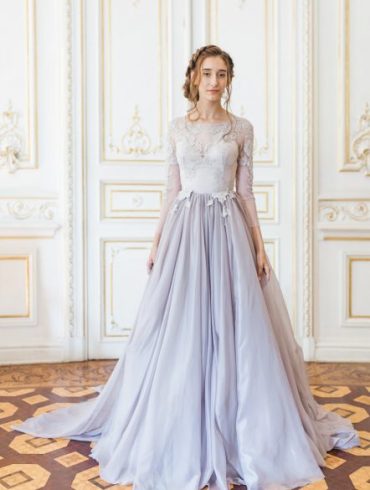
Lavender Dress
Purple is the color of royalty and when it comes to a bridal look lavender is the shade to dress in. This soft, feminine color brings about a more womanly ethos than its blush counterpart. Those that lean towards this pastel shade tend to be quick-witted, fearless, and fun, which is a perfect way to describe an entire wedding day’s theme and decor.
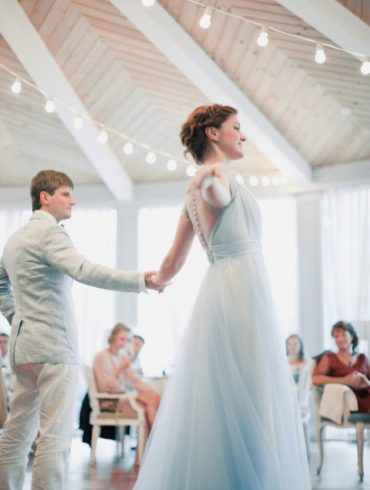
Powder Blue Dress
Blue tones are known for being some of the most calming of the entire color wheel. Associated with the water and sky, it’s also a very natural, organic shade that expresses well among all skin tones. Worn correctly, there’s a certain amount of femininity, loyalty, and confidence that it holds for the bride as well. Perfect for light and airy events.
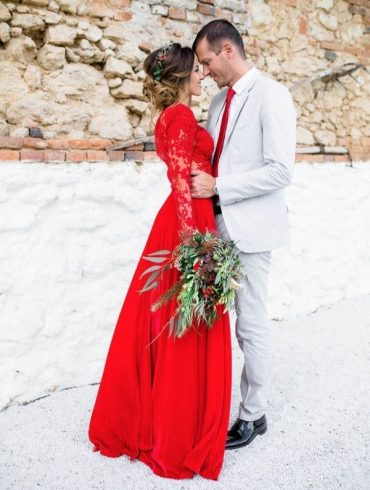
Red Dress
Passion, poise, and sex appeal, red is the boldest of the entire bunch. If you’re looking to bring mystery and power to your bridal look then this is the shade for you. In fact, in many different cultures including Asian celebrations, red wedding gowns are some of the most popular and traditional with its symbolism being that of excitement and energy. In China and India brides wear red to for good luck.
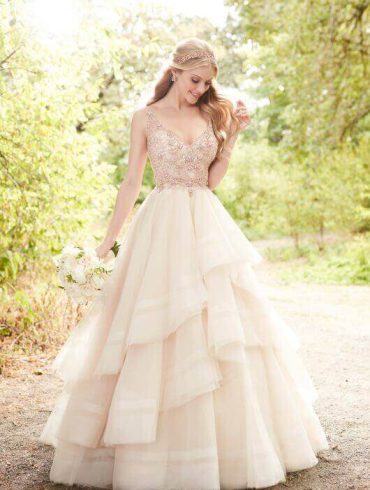
Gold Dress
Glamorous in gold, our most extravagant of brides tend to shimmy into this sparkling, metallic shade. Formal events usually get this kind of shining makeover. But the shade itself is known for being brave, illuminating, and found to be sprinkled with some magic as well. If you’re looking for a fairy-tale style event, turn the tables a bit and find yourself a gold wedding gown.
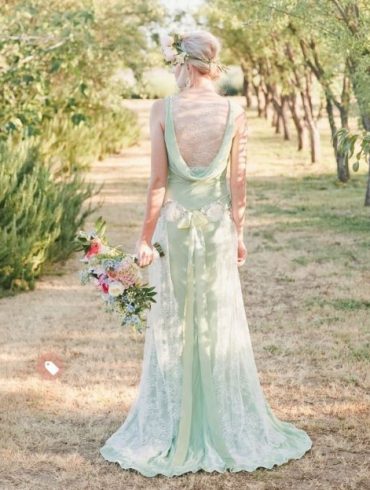
Mint Green Dress
Green is another color that evokes a sense of serenity and peacefulness, similar to blue. But this shade has a bit more of nature’s touch involved. There’s natural ease surrounding these gowns and when it comes to mint a delicate charm as well. Perfect for springtime affairs and ones that have a boho vibe attached, this choice can be such a gorgeous and surprising addition to the big day.
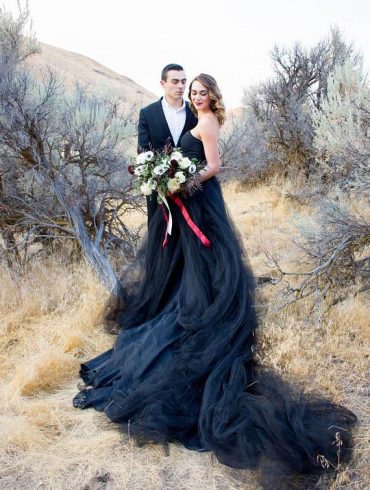
Black Dress
One of the least popular of the bunch is black. For a more formal, modern, and sophisticated of an event, we may see a bride rocking a black gown as she sashays down the aisle. Dipped in this midnight shade, confident, strong women are who decides on one of these elegant designs. Think Sarah Jessica Parker who wore a black wedding gown, or those wanting to represent power.
What’s Your Wedding Dress Personality?
If a picture is worth 1,000 words, then a wedding dress may be worth a million. Your gown is one of the most personal and special dresses you’ll ever wear, and it’s also a statement of self expression. What’s your wedding dress personality?
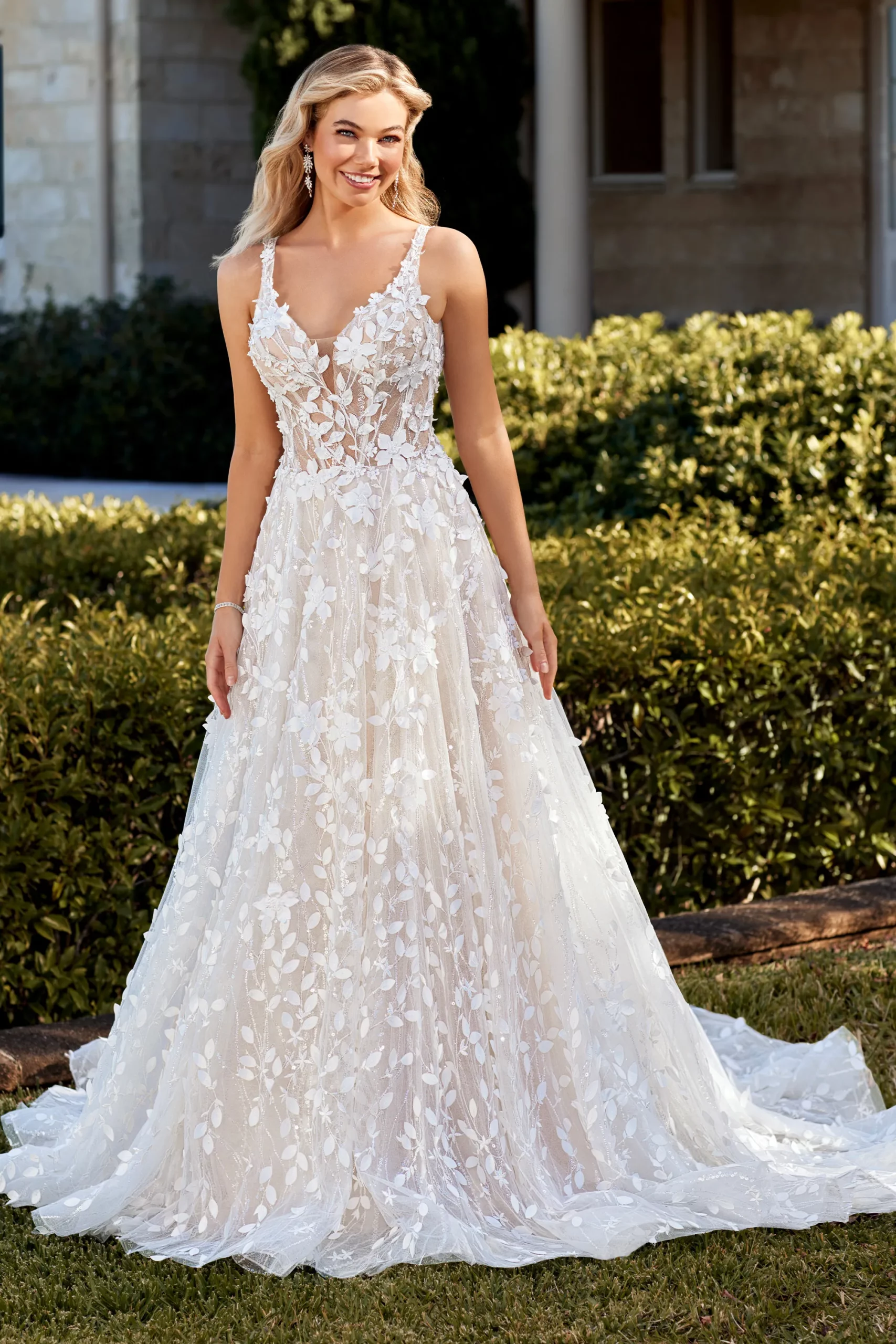
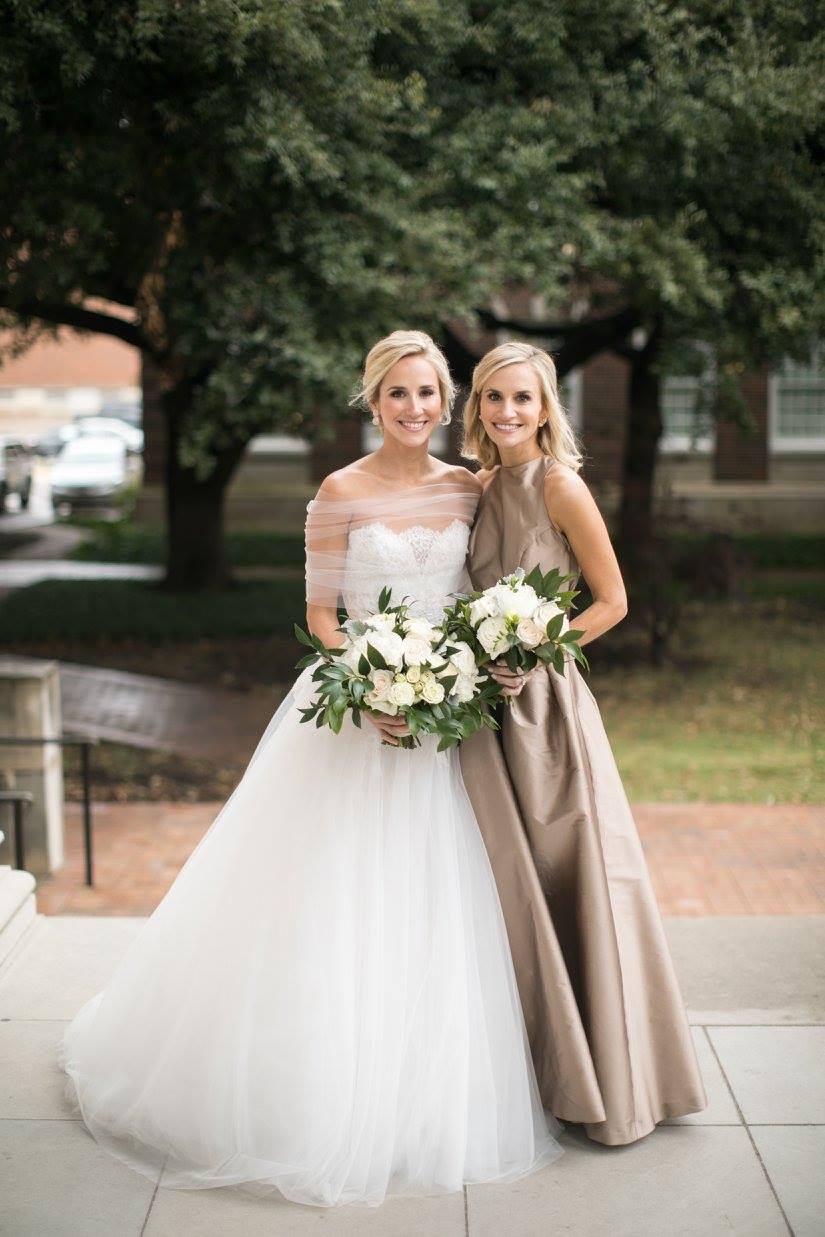
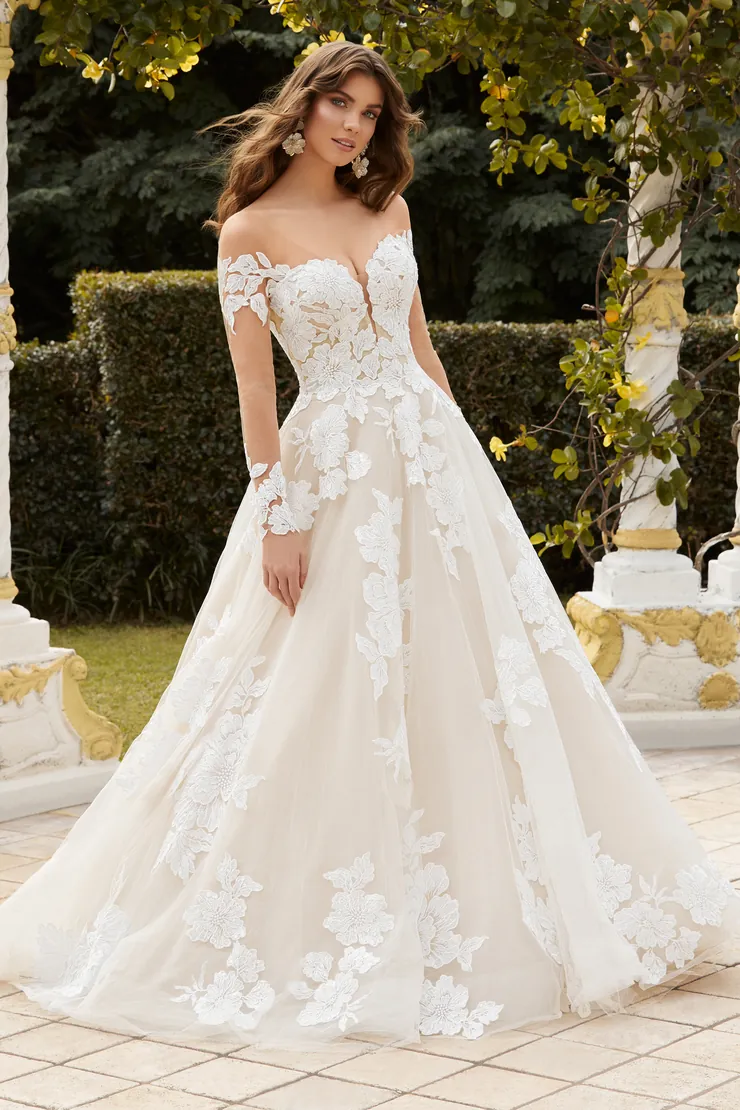
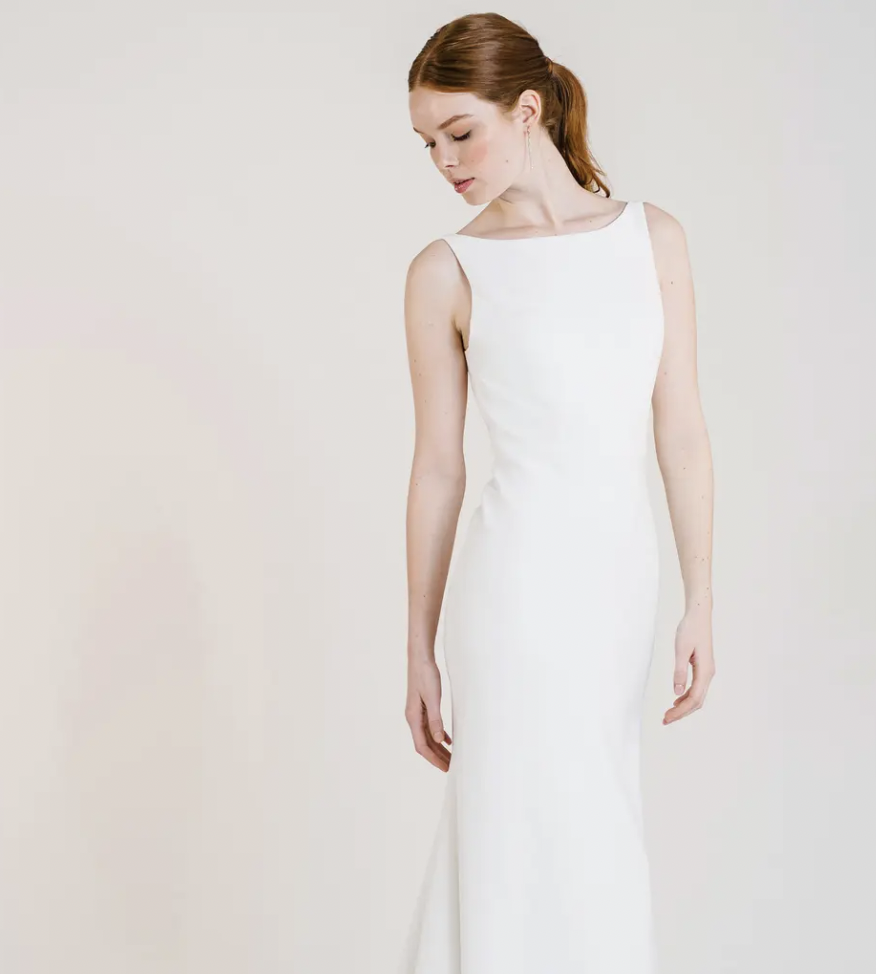
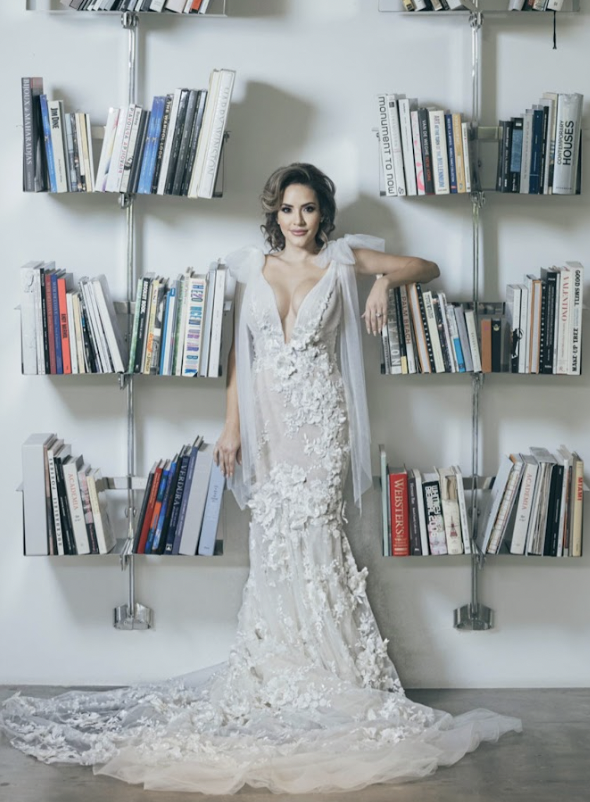
The Best Wedding Dress for Your Body Type
One of the first thing a newly engaged bride does is head to the magazine rack to stock up on wedding magazines. There is something fascinating and totally absorbing about flipping through the pages and pages of amazing wedding dresses. But when it comes to finding the perfect wedding dress for your style and body type, sometimes the process can be overwhelming. We will help brides determine the best styles for their body type, best designers to fit their wedding style and even the best places to shop.
First of all, you want to be the best version of yourself therefore you must determine your personal style. Try a style collage by cutting out pictures from fashion magazines and see what you come up with. For example, are you an Audrey Hepburn type? Do you prefer black and white detail, traditional silhouettes and attracted to solids verse patterns? Wonderful! You would shop for classic/simple silhouettes with detail in the fabric (ex. lace) instead of heavy beading and embroidery. What is your favorite part of your body? On one of the most important days of your life, you want to simply accentuate your assets! Great cleavage? Look for strapless with a sweetheart neckline. Thin arms and defined shoulders? Try halter to show it off! Gorgeous legs? Why not a fun short skirt? It’s your day to look absolutely phenomenal, so have fun and make the most of it! Now that you have these two important pieces of information, the next step is to determine what wedding gown shape will work for you. Below are wedding styles considered best for your body shape.
Pear/Triangle: Narrow on top and fuller and curvier on the bottom.
Pear Shape
If your body is a pear (and you body is thinner on top with more curves/fullness on the bottom half), then your style tips are:
Create balance for your shape by putting the attention on your upper half. Draw attention upwards with one shoulder, strapless, v-neck, bateau or scoop necklines.
Reduce attention your bottom half with ballgown or A-line silhouettes. These silhouettes are fabulous and forgiving for pears.
Skip: Sheaths (because they are too clingy for your shape), Mermaids & Trumpets (they put attention on the wrong half of your body), Halters & High Necklines (because they can create a disproportionate look)..
The key is creating balance! V-neck is your best friend as well as pleats and ruching on top. Plus size ladies: try sweetheart necklines with straps to balance your fuller bottom. Small bust & thin ladies: try a low back
Rectangle: Waist & hip approx the same measurement and no hips.
Rectangle Shape
For brides with a rectangular shape – defined as shoulders and hips are about the same width without a lot of waist definition, then your style tips are:
Create the illusion of curves by drawing attention upwards (strapless, v-neck, one shoulder) or towards the hem (Mermaid)
Define your waistline. An empire waist will showcase the smallest part of your torso. Or a beaded detail or colored sash around the natural waistline will create definition.
Skip: Halter and High Neck, they will make shoulders look narrow and as a result will not flatter your waist. Also skip Sheaths as they will make you look boxy
Hint: Ideally, ruching helps to create a waistline with detail that draws the eye up. A high neck is flattering if you have defined shoulders; sleeves if you have slim arms.
Hourglass: Bust and hip measure equal and waist is defined.
Hourglass Shape
If you have an hourglass shape (think Scarlett Johansson, Kate Elizabeth Winslet, and Catherine Zeta Jones’, full bust and hips and defined waistline) then you have TONS of options for gowns that will flatter.
Style tips for hourglass brides are all about showcasing your proportioned body shape and curves.
Almost any wedding dress will do this, but memaids, trumpets and sheaths do it best.
And an embellished belt is a great way to highlight your waistline.
Really, the only thing you’ll want to avoid are empire waistlines, because they hide the slimmest part of your waist.
Hint: Lucky you. Most wedding gowns are geared to your figure, especially if you are 5’5” or taller! Trumpet skirts are very flattering. Slim and petite: Try a sheath style. Plus size: modified A-line or princess cut is your best bet!
Apple: You are fuller at midsection then your bust or hip.
Apple Shape
If you have an apple body shape – meaning you are top heavy and then get smaller from the waist down, these these style tips will help:
Use lower/plunging necklines draw attention upwards. V-neck and sweetheart necklines are great options.
Elongate your silhouette with a high waistline and a skirt that flows away from the body. Empire waistlines and A-line silhouettes.
Consider showing off your legs with knee or tea length dresses.
Skip: Mermaids and Trumpets, they will accentuate the widest part of your frame and flare at the slimmest. Ballgowns because they won’t elongate your silhouette. Straight Across Strapless necklines because they won’t accentuate your bustline.
Hint: Empire waist is your ideal style. Slim apple: Natural waist detail such as a sash or band helps create a waist.
Wedding Dress Shopping Quick Tips
Finding the right wedding dress can be a daunting task. No matter the vision, theme, style or formality of the celebration, choosing the right design can be the most fun, yet the most stressful, part of the entire planning process. But there’s a bit of advice to follow if you want to ease the experience. Don’t go to the first bridal salon without doing some prepping. Instead of filling yourself with worries and walking into your appointment blindly, we’re sharing 5 secrets to finding the perfect wedding dress – along with a few absolute DON’Ts to keep in mind as well!
Five Things Every Bride Should Know About Wedding Dress Shopping
Start with an open mind
After you get engaged (yea!) you’ll probably have some idea of the of dress you want. Keep that vision, but be willing to trying different necklines, silhouettes and fabrics. Brides are often surprised about what looks best on them. Or how different a dress looks on – than on the hanger. And a romantic (or sexy, or glamorous, or your ideal look) can definitely be achieved with more than one style of dress. So be open to your options.
It is your decision
Wedding dress shopping is just plain fun. And everyone you bring to the salon is excited and happy for you. But everyone also brings their own opinions to the dressing room. Remember that it is your day, and your decision. Your mom, no matter how much she loves you, has already had her day. And your bridesmaid has, or will have, her own too. Think about what you want. And be kind, but firm, about getting it.
Salespeople are trying to help you.
But they are also trying to sell to you. A good salesperson will guide you in finding your dress. And she really will be truthful about what looks good on you and what you can afford. But she is also trying to sell you something she has, in her store. And she wants to sell it to you at this appointment. If you fall in love, perfect. But if don’t, don’t let sales pressure be a factor in your decision.
Fit is everything
A dress will go from good to gorgeous with the proper fit. This means both the proper undergarments and the proper alterations. Let the consultant guide you about what the proper fit will do for your dress. And make sure you have the right undergarments on – every time you try on a dress.
You'll know when it is “THE” dress
It is probably no surprise that I watch a lot of “Say Yes To The Dress.” I swear I can tell when a bride has found her dress by how she walks out of the dressing room. When you find your perfect dress you really do just know. It is as much about how it looks as it is about how it makes you feel. Don’t stop looking until you find the dress that makes your heart a little faster and makes you really feel like the bride you are.
Here Are Five Secrets to Finding the Perfect Wedding Dress
Finding the right wedding dress can be a daunting task. No matter the vision, theme, style or formality of the celebration, choosing the right design can be the most fun, yet the most stressful, part of the entire planning process. But there’s a bit of advice to follow if you want to ease the experience.
Make Early Appointment Times At The Salons.
Try and make your appointment times in the morning. You get a fresh-faced staff that hasn’t been on their feet lugging dresses around all day – or dealing with Bridezillas for five hours. You’ll also feel more energized yourself (and not bloated from lunchtime with the fam).
Do Your Research On Silhouettes.
If you don’t already know, do some research on wedding dress silhouettes. From trumpets to a modified A-line, you’ll have a better idea of what to shop for or what your bridal stylist is talking about when you hit the racks. Also, you’ll have a better idea of what you’re personally interested and what looks good on your body type!
Try On Before You Eliminate Completely.
Before you decide that you want absolutely no lace or you can’t have anything other than full-length sleeves, try on some different styles. So many times brides will walk into a salon with everything they don’t want and walk out with a gown that had those same elements. You may surprise yourself, so stay open-minded!
Do Wear The Right Undergarments.
Make yourself more comfortable by going into your appointment with the right undergarments on. Whether you feel best in a pair of Spanx to suck up your tummy or a comfy pair of full-coverage panties, don’t worry about the stylish that’s helping you, they’ve seen it all already.
Take Photos – If Allowed.
Some bridal salons and boutiques won’t allow photo taking but when you’re able to – GO FOR IT. Take a lot of photos and take them at every angle. If you love a dress and love how you photograph in it, then come the day of, you’ll feel more confident than ever before.

